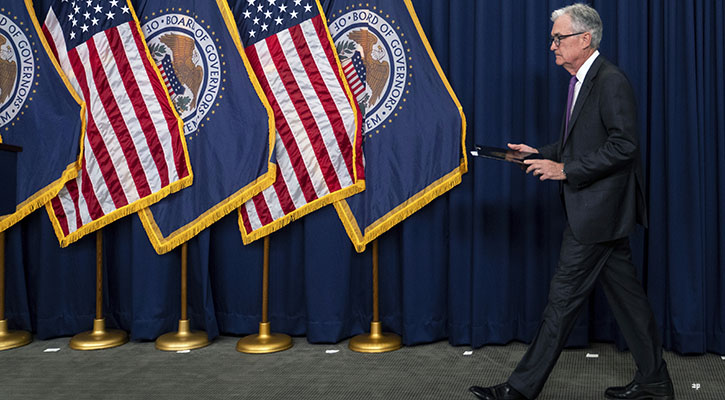
While the Federal Reserve’s projections and Chair Jerome Powell’s remarks tilt in a hawkish direction, we continue to expect the central bank to cut interest rates aggressively over the next two years.
The Fed elected to keep the federal-funds rate unchanged at its Wednesday meeting — the outcome expected by most market participants. But investors want more insight into the Fed’s next steps. Is it done hiking rates? And when (and by how much) will it cut them?
The federal-funds rate now stands at a target range of 5.25%-5.50%, following 5 percentage points in hikes implemented from March 2022 to July 2023. The size and speed of these raises exceed those of any Fed tightening campaign since 1980.
"Both [U.S. and Canadian] central banks are likely to be on hold for a long time," said Canadian bond manager Tom O’Gorman earlier this year, "as monetary policy acts with a very long lag."
Powell noted that the “full effects of tightening are yet to be felt” on the economy, which we agree with. It remains highly uncertain to what extent the hikes will further slow down the economy, and how this will translate into getting inflation back down to the Fed’s 2% target.
The tenor of Powell’s remarks in Wednesday’s press conference was hawkish, matching his speech at Jackson Hole, Wyoming, in August. He continues to emphasise the risk of the Fed insufficiently tightening to bring inflation down while giving short shrift to the risk that overtightening may push the economy into a severe recession.
This accords with the Fed’s updated economic projections (the median expectations among FOMC members). The Fed now expects the federal-funds rate to stand at 3.9% at the end of 2025, up from its earlier 3.4% prediction.
We continue to expect a faster pace of Fed funds rate cuts than what the Fed currently projects, as we’re anticipating a faster pace of inflation reduction. We project fourth-quarter 2024 year-over-year core PCE inflation of 1.9%, while the Fed projects 2.6%.
Additionally, we project 2024 fourth-quarter year-over-year U.S GDP growth of 1.0%, compared with the 1.5% projected by the Fed. In our view, this will lead the central bank to cut aggressively in 2024 and 2025. We expect the Fed to lower the funds rate to 3.50%-3.75% by the end of 2024. That contrasts with a median forecast of 4.5% from the Fed and expectations in the bond market of between 4.5% and 5.0%, as shown in the CME FedWatch Tool.
In addition, we see the Fed pushing the funds rate down to 2.00%-2.25% by the end of 2025 – much lower than the Fed’s expectations of 3.75-4.00%.
We expect continued supply-side improvement to help drive inflation down over the next year, while lower GDP growth (and commensurate lower labor demand) also exerts a downward influence. Once inflation returns to about the Fed’s 2% target and GDP growth begins lagging trend growth (which is at least 2%), the Fed will begin cutting swiftly.
Downside Risks to the Economy
We’re more attuned to the downside risks to economic activity than what the Fed is acknowledging. The real five-year U.S. Treasury yield, which adjusts yields for expected inflation, stands at about 2.2% — the highest it’s been since 2007, excluding a brief aberrant spike in 2008. We see the strain of high interest rates as likely to progressively accumulate throughout the economy. There is a possibility of abrupt downward jumps in financial conditions as balance sheets at various entities are pushed beyond their breaking points.
Still, we expect the Fed to move adroitly in 2024 to start easing monetary policy before conditions deteriorate into a severe recession. Admittedly, the Fed’s initial response to the inflation spike in 2021 and 2022 was sluggish, suggesting an inability to respond to turning points. But those were very unusual circumstances. By contrast, we saw the Fed move quickly in 2019 to ease monetary policy slightly as a precautionary measure, despite little weakening in economic activity playing out in the data.









.jpg)










